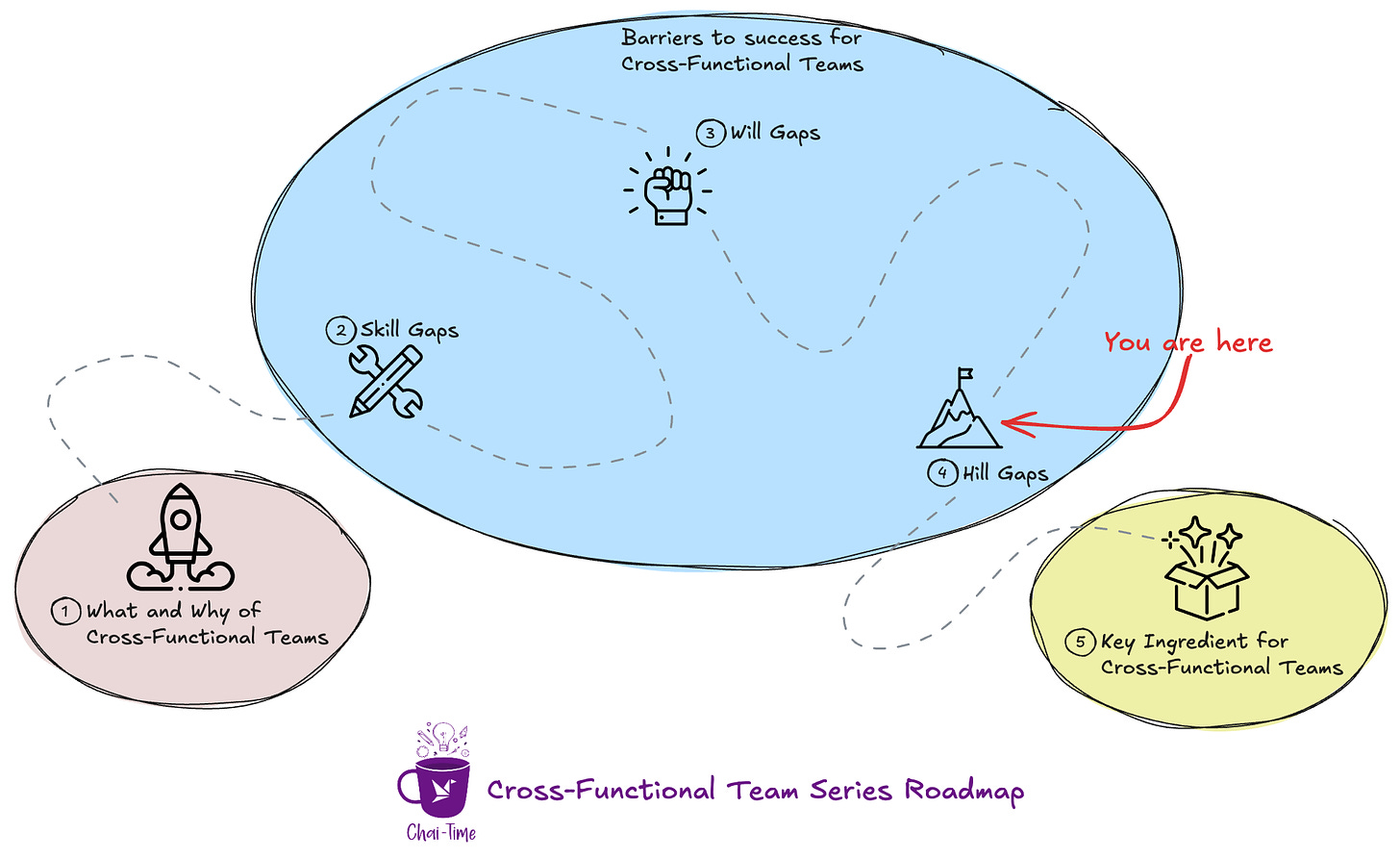Power Dynamics
The fourth post in ChaiTime's paid-subscriber series on Cross-Functional Teams (CFTs). This one deep-dives into Will Gaps that are a barrier to success for CFTs.
I remember the first few days of most of my cross-functional team experiences very well. Not for their smoothness or brilliance. But for their chaos and confusion.
The usual flow seems to be this: executives find a cross-functional problem. Some folks from each area are chosen for the cross-functional team. People are selected by either being nominated or volunteering. The team is set up, then left alone to do great things. But more often than not, they fail.
This week we’ve explored a few reasons why cross-functional teams fail. These include:
Skill gap - Team members lack the skills to succeed in cross-functional teams.
Will gap - Team members lack the motivation to succeed on cross-functional teams.
Today we’ll add another reason to the list of why cross-functional teams fail:
Hill gap - The team faces environmental factors like bad leadership or poor structure.
Your series roadmap as usual here!
Who’s in charge here?
Here is how the first day went for one of the best cross-functional teams I worked on. At our very first meeting, a woman welcomed us all and had an agenda ready. The agenda had time for us to introduce ourselves and do some icebreakers. In later meetings, she gently nudged and questioned us. In the end, we all had the same goal. Throughout my work on this team, I had complete confidence that this woman was our lead. I'd often ask her for advice as we worked together.
I was surprised to find, while writing her a glowing peer review for performance review season, that she was the most junior team member!
This experience shows that the organizational structure in a cross-functional team can be very different from conventional org structures.
Consider becoming a paid subscriber to ChaiTime today!
Paid Subscribers get access to the full post archive and in-depth, special series like this one each quarter.
Heterarchy
One interesting term I came across in my study of cross-functional teams was Heterarchy. Here is how one research paper (Aime et. al.) defines it:
Heterarchy is a shifting power structure. Power moves between individuals based on the situation.
Heterarchy is the opposite of Hierarchy which has a traditional top-down organizational structure. Heterarchical teams and organizations have complex connections. No one is clearly in charge at all times. The “who’s in charge” answer changes depending on the situation.
Heterarchy is seen in many organizational structures today. In his book of the same name, General McChrystal talks about how the “Team of Teams” structure is used in the armed forces. You might have heard of this by another name: Matrixed Organizations.
General McChrystal also changed my perspective about how to view the cross-functional team lead role. The role is still important but it shifts from Leader-as-Chessmaster to Leader-as-Gardener.
I have seen Heterarchy at play many times in my own cross-functional team experiences. At times, I've seen the product, engineering, and legal experts take over because the situation required it. Everyone else deferred to them because it was clearly their area of expertise. Here is another Heterarchy-in-the-wild example from
.As an individual contributor in a Heterarchical organization, you may feel like you have multiple bosses. That's its biggest drawback. Here are a few lessons from my years in Heterarchical organizations. I hope they help you.
1. Information conduit
Think of yourself as a link for information. Don't assume your bosses always communicate. So, share updates and ask questions. Importantly, alert them about conflicting orders or feedback. They might not realize the issue until it's too late.
2. Performance reviews
Talk to all your bosses about your performance review. Sometimes, only one boss may be in the right room to advocate for you. So, share everything they need to know about your work and its impact. Also, ask for reviews from your other bosses and keep them updated. This ensures a fair evaluation.
3. Escalations and conflict management
Don't be afraid of escalations. Escalations are a form of conflict management. If you can't resolve a conflict with your co-workers, despite your best efforts, you may need to involve your bosses. Don't be afraid of doing that if necessary. Sometimes there may be a conflict between your bosses. Make it visible and don't be afraid of escalating further if necessary. Whatever you do, don't try to sweep the conflict under the rug because it will fester and come back to bite you!
4. Power dynamics
At all times keep up your situational awareness and track “who’s in charge”. the more you do this, the more you’ll become aware of the power dynamics in your team.
5. Your unique position
People in matrix organizations are part of many groups. This setup offers them insights unavailable to those in traditional organizations. So, leverage this advantage. Step back for a broader view or dive in for details. Use these insights to make a bigger impact!
Readers, have you worked in Heterarchical team structures?
What was your experience like?







